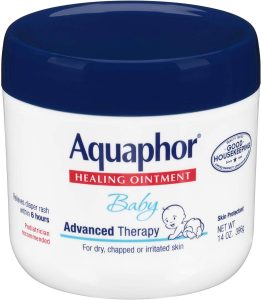Getting an infected tattoo is one of the scariest things you’ll probably experience in life. Here you are thinking you’ve finally made it out of the danger zone, a.k.a. the tattoo parlour. But if you contract a nasty tattoo infection, you’ll be in for a different kind of pain! In this article, I’ll cover all the bases of an infected tattoo – the causes, symptoms, and of course, treatment options.
Page Contents
Tattoo infection vs. tattoo allergy
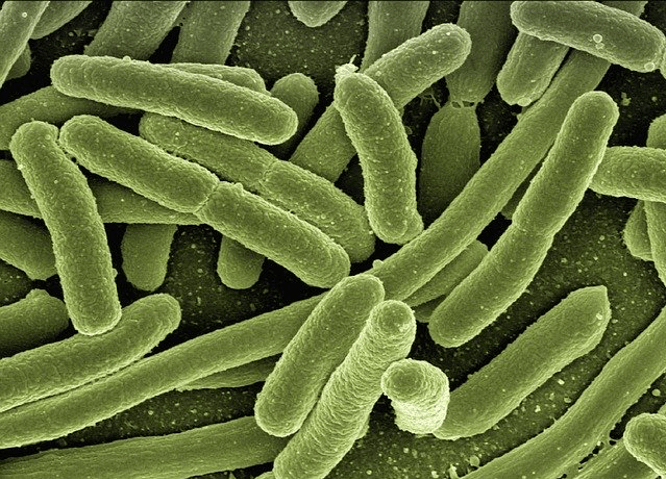
E. Coli bacteria (Photo by Gerd Altmann)
A lot of people confuse a tattoo allergy with an infection. And it’s easy to see why – during the first few hours or days, the symptoms may appear to be very similar. Now, since I’ll be talking about tattoo infections throughout the rest of this article, please allow me to explain what a tattoo allergy is:
Common signs of an allergic reaction include redness, swelling, rashes, and flaking in the tattooed area. Unfortunately, some people are more susceptible to allergies than others.
For instance, let’s say you have eczema or dermatitis (these are common enough skin conditions). Chances are, you may be more prone to getting rashes where your tattooist’s gloved hand applied pressure on your skin… (yes, some people are that sensitive).
Additionally, you may also be allergic to tattoo ink. The most common offender is red ink (although other colours are to blame as well). This is because tattoo ink ingredients can include manganese, cadmium sulphide, cobalt chloride, iron oxides, and mercury salts. And you may be allergic to any of these.
Tattoo allergies can be mild or severe. For relatively mild symptoms, an antihistamine or an antibiotic may do the trick. However, if you suddenly puff up like a balloon, then you may have a serious allergic reaction! Don’t waste any time – head straight to the emergency ward.
In worst case scenarios, the tattoo may need to be removed especially if you turn out to be deathly allergic to the ink. Can’t have that staying in your skin for the rest of your life!
15 common causes of tattoo infections (a.k.a. how to prevent getting an infection in the first place)
Infections can’t be avoided altogether, but there are ways you can minimise the risk. That said, here are some common causes of tattoo infections, so you know exactly what to look for (and avoid):
1. Unsanitary tattooing conditions
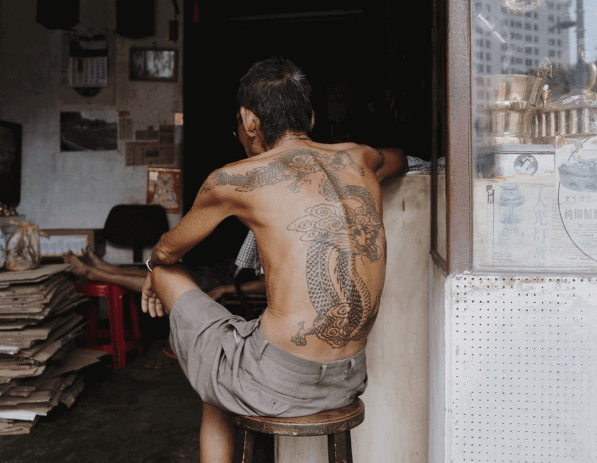
Please don’t get tattooed in a place like this (Photo by Jousi Osorio)
Don’t look for the cheapest tattooist in town. This includes saying ‘no’ to tattooing yourself using DIY tattoo kits you can buy for a few quid online. Most cheap rates are quoted by amateurs and scratchers who are most likely going to use you for tattoo practice.
I would assume you wouldn’t want to be practised on. And no, we’re not talking about stick and peel tattoos, we’re talking about permanent tattoos here.
Professional tattooists, especially in the UK, are required by law to follow stringent procedures to ensure their clients’ safety. Local authorities are bound by law to regularly inspect registered shops. They make sure tattooing equipment and the entire workplace is clean.
2. Re-using needles
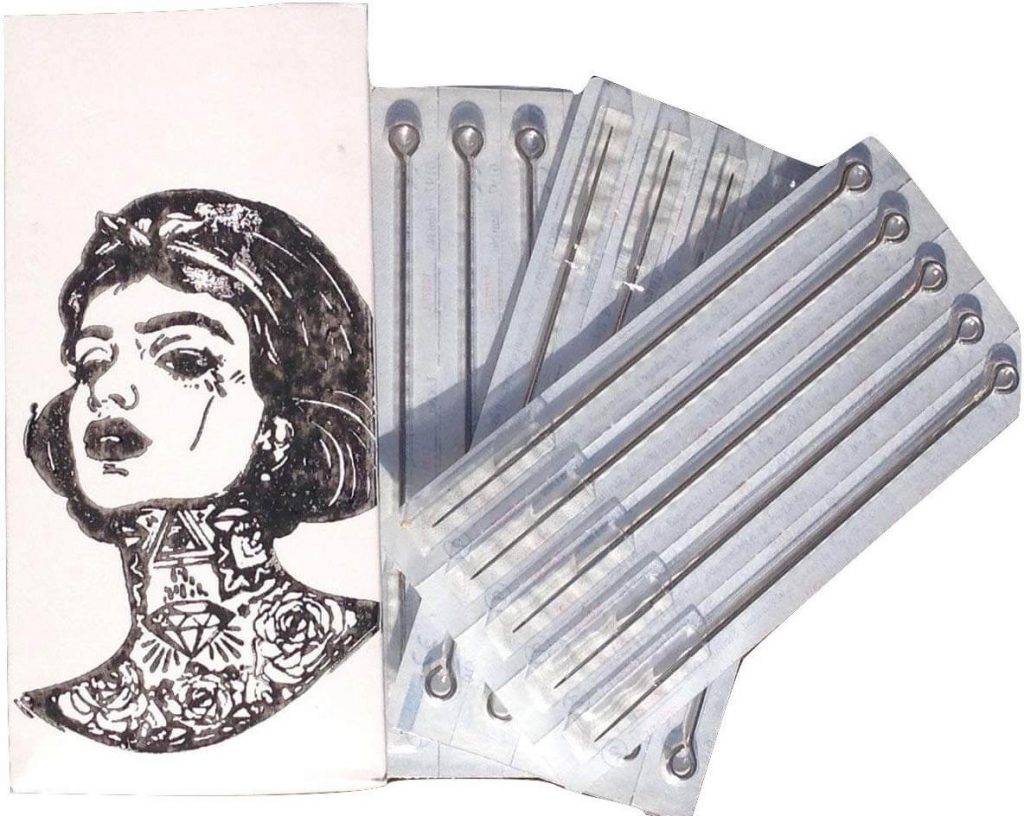
Example of single-use needles (click here to buy on Amazon)
Needles aren’t meant to be reused, unless of course, you’re using them to sew clothing or something similar. But for needles that go on the skin, well, it’s just a big no-no. Even if you boil or light a needle on fire, or soak it in alcohol for hours, it’s still not a guarantee that it’s bacteria-and-germ free. An autoclave may do the job, but it’s way too expensive even for most tattoo shops. Most resort to using single-use needles bought in bulk.
If you’re wondering what kind of diseases you can get from tattoos, well, here’s the answer. Shared tattoo needles can result in HIV, MRSA, Hepatitis B and C. There are more possible blood-borne diseases, depending on what the needle came into contact with.
3. Ineffective wound cleaning
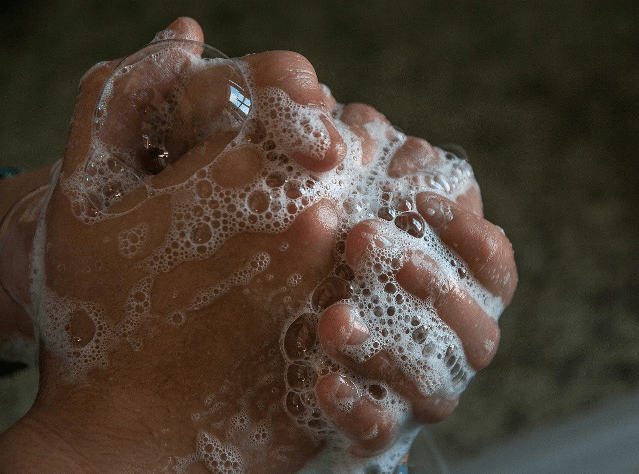
Hand washing is important in tattoo aftercare (Photo by Jacqueline Macou)
Cleaning the wound is an important step in the aftercare process. Your first wash will normally be done a few hours after your tattoo session. Note that this will vary depending on your tattooist – some may tell you to leave the cling film on for 24 hours.
What’s important is that once you remove the film, you’ll notice blood and plasma and ink all mixed in together. It will look disgusting, but it’s all part of the process. What you do is remove the film and thoroughly clean the area with warm water and antibacterial soap.
Oh, and make sure you wash your hands first before you touch the tattoo. It will be tender to the touch, so you need to be extra careful. Let the wound dry up a bit (but not too dry). Then apply ointment like Aquaphor or A+D to protect the tattoo whilst still letting some oxygen in (important to the healing process).
Aquaphor Healing Ointment is great for new tattoos
Don’t just clean your wound once a day. In the beginning, you may need to clean up maybe 2-4 times a day, depending on how big the piece is and how much plasma your body is generating.
You don’t want the plasma to stick to the skin for longer than necessary because it can turn into thick, unsightly scabs. And, yes, if the area’s unclean for too long, infections are bound to happen.
4. Poor aftercare instructions
This shouldn’t be a problem if you hire a professional tattooist because they’re going to give you aftercare whether you ask for it or not. They’re required by law to do so. Plus, you’re also part of their portfolio (the walking version, that is).
Experienced tattooists will only give you aftercare instructions that have been proven to work with their other clients. That said, when you go the cheap route, you’re more likely to receive dodgy or incomplete instructions from your ‘artist’.
The point of aftercare is to help your tattoo heal as fast as possible. Poor instructions will only lead to infections which can further delay your tattoo’s healing, something I’m sure you’d like to avoid at all costs.
Here’s an infographic outlining how to do proper aftercare:
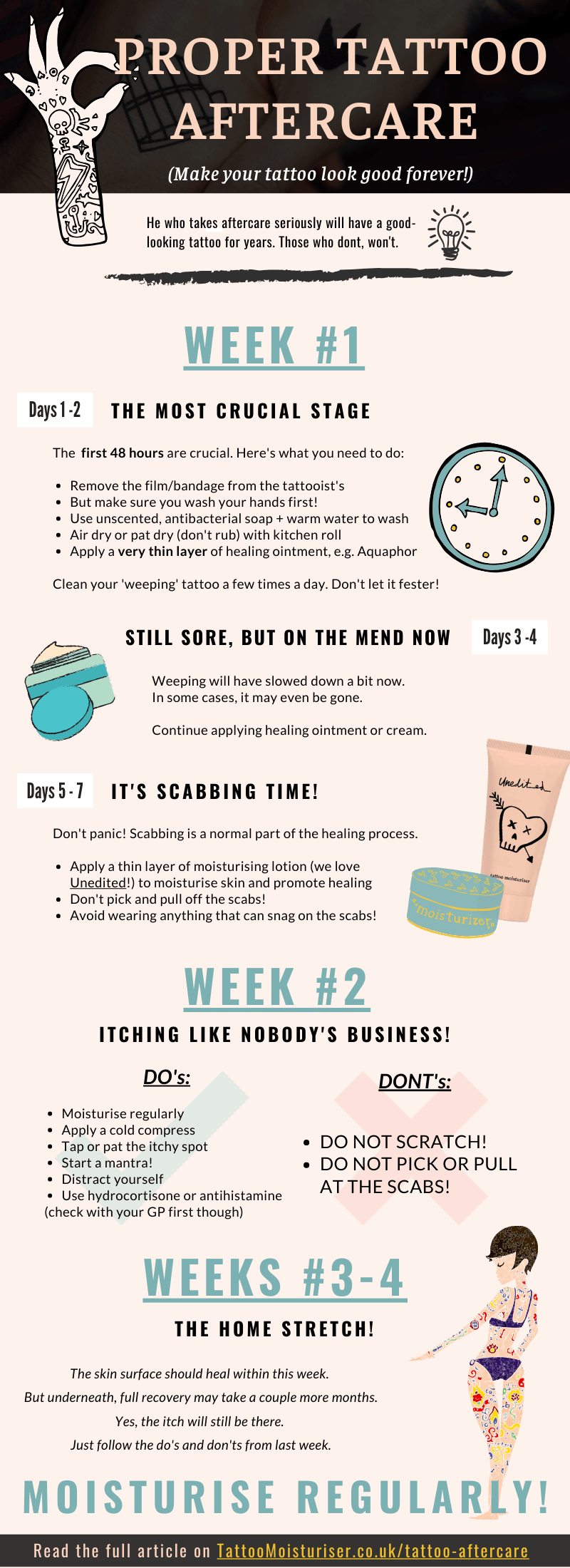
5. Using expired aftercare products
It’s your tattooist’s responsibility to give you aftercare instructions. But it’s your job to make sure you don’t purchase products that are already expired. Always check your item’s expiration dates.
The downside, however, is not all products have a best-before-date label on them. If unsure, always check the colour, texture and smell to ensure they’re still the same (this is easy to do if you’ve used the product before).
For products, you’ve previously not used before, it will be a bit hard to determine. I highly recommend just getting a new bottle or tube, so you don’t risk your health and your safety.
6. Tattoo re-wrapping
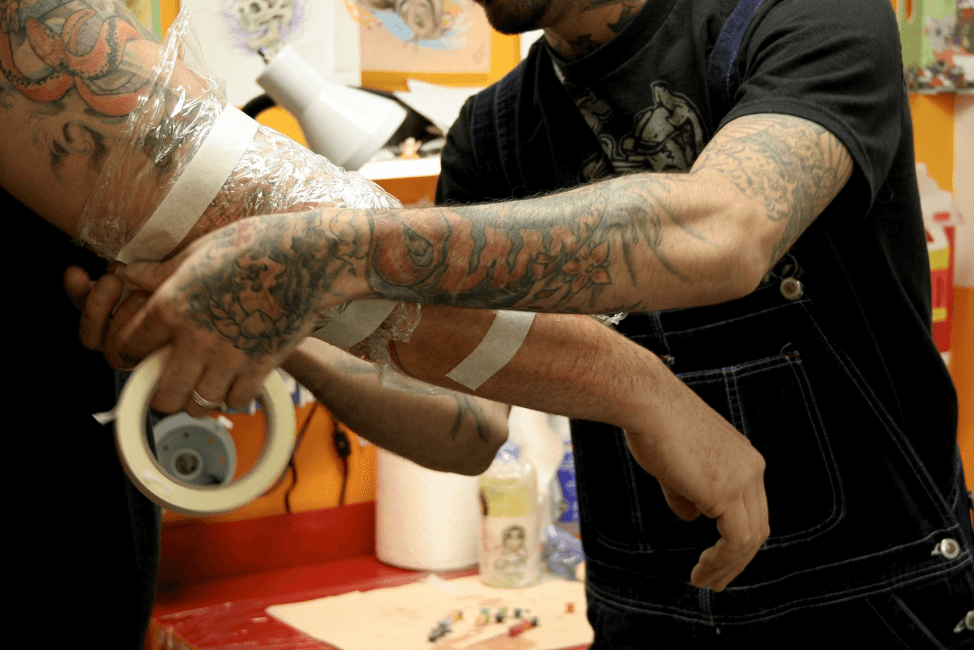
Tattooist putting on cling film on his client’s brand-new tattoo (Photo by Angie Torres)
Most tattooists discourage re-wrapping your brand-new tattoo when you get home. This is because your home is different from a thoroughly disinfected tattoo studio environment.
Tattooists take great care at cleaning their workplace, so you know that when they wrap your tattoo, there’s very little chance that germs and bacteria are going to get trapped inside the film.
However, when you attempt to do the same thing at home, you’re most likely NOT going to be able to eliminate all possible sources of contamination. You’ll have dust, dirt, pet hair, and various other contaminants around you – and it’s highly likely you’ll have more than a few trapped in the film. Couple that with a moist, unhealed tattoo, and you’ll have the perfect recipe for a painful infection!
7. Picking or pulling scabs off
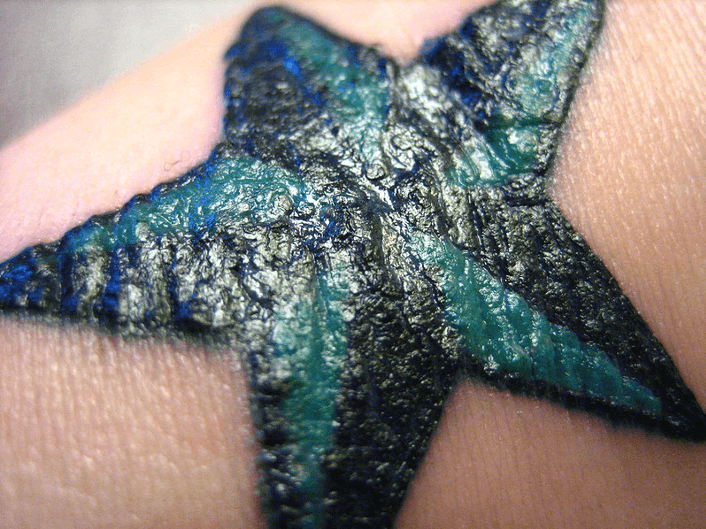
A scabbing tattoo (Photo by Amanda from Flickr)
I know how tempting it is to pull scabs off your new tattoo. Trust me, I’ve done it far too many times on my own wounds. But when it comes to tattoos, you’re going to have to ignore your instinct and try your hardest to NOT pick the scabs. Instead, you need to wait for them to fall off on their own. Otherwise, you risk pulling some ink out of your skin (and thus cause some blank spots on the tattoo).
But how do you get an infection from pulling off scabs?
Well, if you pull off scabs with dirty fingers and fingernails, then chances are, your unhealed tattoo is going to get infected. It’s not like you’ll remember to thoroughly wash your hands before picking off that ugly scab, right? So, better resist the temptation!
8. Bathing in dirty water

Soaking your new tattoo is a big no-no (Photo by Naomi August)
Soaking in the tub after a long hard day at work is so relaxing, but not if your skin’s still raw and oozing some plasma and blood. Submerging your wound in water isn’t a great idea because grime from your body is going to get trapped in that water! The moment all those germs and bacteria come into contact with your unhealed skin – that’s the beginning of an infection.
But what if you really, really need to take a bath?
Nobody’s telling you not to take a bath, just don’t submerge your wound in water. That said, quick showers are great for cleaning your tattoo and, of course, for helping you feel clean after a hard day’s work.
9. Using too much aftercare product
During the course of the healing process, you’re going to be using a number of different aftercare products. For instance, you’ll be using antibacterial, unscented soap to clean the wound a few times per day. Then you’ll be using healing ointment to protect it from the elements and encourage healing at the same time. Once it starts scabbing, moisturising lotions are up next.
The point is that you shouldn’t suffocate your wound with too much ointment or lotion. Because if you do so, then you’ll be blocking out oxygen from entering the skin. A light, thin layer is all you need to apply to do the job.
Check out Hustle Butter, Butter Up, Cetaphil, or Aveeno – any of these products can help moisturise and hydrate both new and old tattoos!
10. Your immune system
Some people are just more prone to infections than others. You can certainly try living a healthy lifestyle to minimise the risks of contracting an infection. But if you’re one of the ‘unlucky’ ones, then you’re most likely bound to get an infection no matter what.
On the other hand, some people can live in dirty homes and expose their unhealed tattoos to unsavoury conditions, but they remain unscathed. It’s quite mind-boggling, to be honest.
If you’re not sure which camp you belong to, then it’s best to just do the right thing and start living a healthy lifestyle, if you aren’t already.
11. Pre-existing medical conditions
If you’ve got a pre-existing medical condition that you think may be compromised if you get a tattoo, then you better ask your GP first if a tatt is a good idea. You don’t want to get a spur-of-the-moment tattoo, and suffer the painful consequences later on.
For instance, if you have skin cancer then a tattoo is most likely a terrible idea for you, no matter how small the design is. If you’re pregnant, or at least planning to, then you also may want to hold off on a getting a tattoo right this very minute. Consider waiting until after you give birth or stop breastfeeding.
12. Dirty room / house / work environment

A dirty house is not an ideal place for a brand-new tattoo to heal (Photo by Jonathan Borba)
It’s not just a dirty tattoo parlour you need to worry about. Think about your living conditions, too. After all, you’ll only be spending a couple of hours max at the tattooist, but you’ll spending most of your time at home and at work.
Cleaning up your home is relatively easy than cleaning up your work environment, especially if you work in a factory and you don’t have your own office. Observing proper aftercare is key here, but a dirty environment isn’t going to do you any favours. So, while your tattoo’s still in the process of healing, protect it like you would a newborn baby.
13. Letting others touch the area
There’s nothing wrong with showing off your brand-new skin art. You’re mighty proud of it, especially if it represents something near and dear to you. However, showing off and letting others touch your tattoo are two different things.
Keep your gawking admirers’ at arm’s length, and you’ll be fine. Letting them too close – or worse letting them touch it – should be avoided at all costs. Especially if your skin’s outer layer is still unhealed. You don’t know where their fingers have been – you’re literally leaving your tattoo at their mercy.
14. Exercising right after getting the tattoo
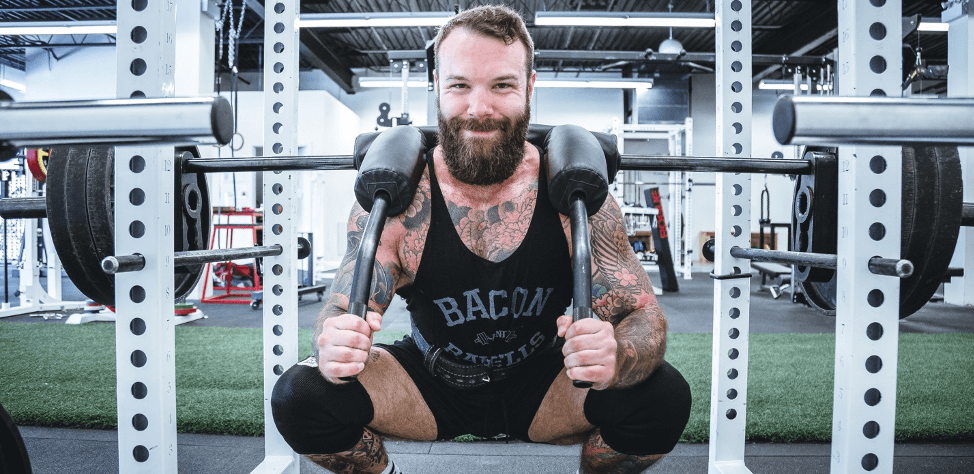
You need to take a gym break after getting a tattoo (Photo by Alora Griffiths)
Light exercise is fine, as long as your tattoo isn’t going to get rubbed and chafed. However, most experts say not to workout within 48 hours of getting tattooed. If you must, go to the gym before getting tattooed. This way, you’ll only be exercise-deprived for slightly over a day.
Also, it matters where your tattoo is. For instance, if you had one on your wrist or your ankle (exposed areas), then exercising should pose no problem. However, if you had a full sleeve done or one on your back or thigh (places which can get rubbed by clothing), then you may need to wait until the tattoo’s fully healed.
Dirty, sweaty clothing that rubs against your tattoo can infect it. Additionally, even if you don’t end up getting infected because you have a strong immune system, you could still experience ink loss which can disfigure your tattoo.
15. Wearing dirty clothing
You might think this is pretty common sense, but you’ll be surprised. Some people wear dirty clothing from the day before without thinking of the consequences. That dirty piece touches your tattoo, and boom! Instant infection.
Sure, ointments like Aquaphor act like a barrier, but that can still be wiped off easily by your dirty shirt. And sure enough, you’ll have hordes of germs just waiting to get in and infect your tatt!
How to tell if your tattoo is infected: 14 common signs and symptoms
A lot of our readers ask us ‘what does an infected tattoo look like?’ Does it look red, bumpy or raised? Is it itchy? Or is it oozing pus? Here are the most common signs and symptoms of an infected tattoo.
1. Redness
Expect the area to be a bit red for a day or two. It’s still sore from all the needles poking holes into it. But if the redness lasts more than a few days, and there are other symptoms present as well, then you most likely have an infection.
2. Swelling
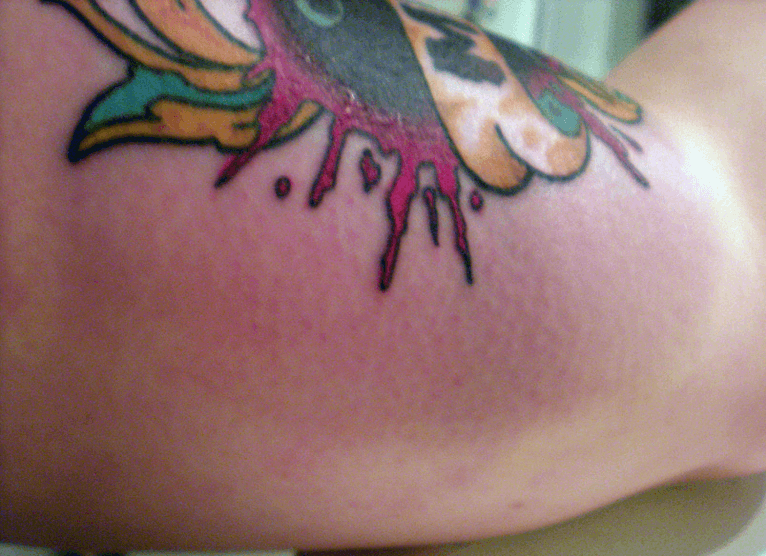
An obviously swollen tattoo (Photo by Kim Laurenson)
Just like redness, swelling is also normal for new tattoos. However, if you notice the swollen area growing bigger instead of returning to normal, then you may be experiencing the early stages of an infection.
3. Pain
Oh, yeah, pain becomes quite normal once you get into tattoos and tattooing. However, you would expect pain to subside after a few days. If, instead of finally experiencing relief, the pain seems to radiate and grow from not just the tattooed area, then you’ve most likely contracted an infection.
4. Extremely high fever
Feeling feverish after getting your tattoo? Depending on the size you got, it’s most likely normal. Technically, you just came off a puncturing session with your tattooist. Your immune system’s going to be on hyperactive mode to protect you. But if the fever doesn’t wane the following day or two, then you may be down with something.
Sepsis isn’t too uncommon with tattooing, especially if you chose a scratcher or non-professional to work on your skin. If you experience high fever, shortness of breath, clammy skin, increased heartrate and extreme pain, then you may have sepsis. Don’t self-medicate; go to hospital straight away!
Here’s a useful sepsis infographic to help you out:
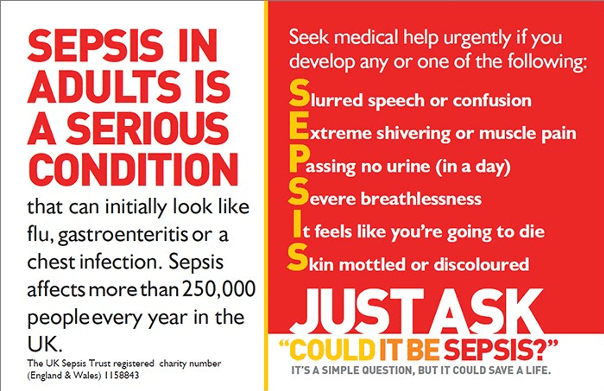
Image source: Royal College of Surgeons
5. Extreme tiredness
You shouldn’t be too tired a day or two after getting your tattoo. Unless, of course, you work in a high-pressure job and it’s mentally or physically taxing. But if you feel extremely tired and you’ve got a fever and other symptoms on this list, then you may have inadvertently contracted an infection somewhere along the way.
6. Rashes
Rashes look like tiny pimples on skin. These can be the sign of either an allergy or an infection. However, for allergies, these will only last for a few days. If your rashes look like they’re going to stay for good, and continues to expand outward from the area, then you may be looking at a tattoo infection.
7. Itching
Itching’s pretty normal, especially once the tattoo starts to scab. But not all itches are the same. Some are a sign of healing (especially when tattoo starts to scab) and more severe itchiness are a sign of a more foreboding infection. This is especially true if you experience other symptoms, an infection may be likely.
8. Extreme scabbing
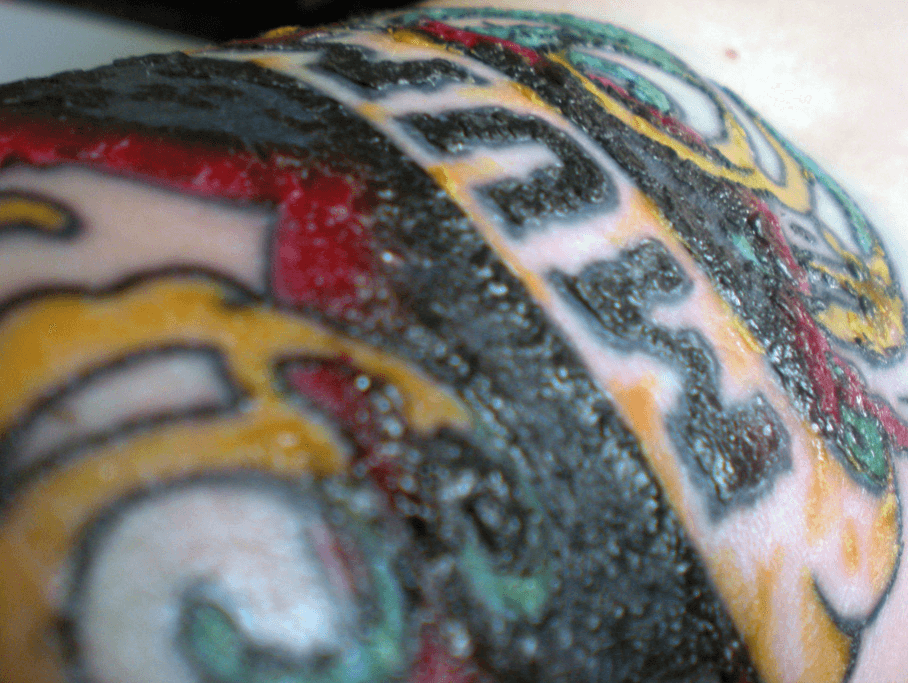
This tattoo’s got very thick scabs (Photo by Kim Laurenson)
Scabbing is but a normal part of the tattoo healing process. But if you don’t clean your tattoo well, and there’s still dried blood and plasma all over your tatt, then you’re more likely to experience extreme scabbing. Underneath the thick crust, since you didn’t clean up well, then it’s also a great place for germs and bacteria to multiply. Which is, in turn, a great infection starter!
9. Foul odour
Tattoos aren’t supposed to smell bad. If you clean it regularly, that is. One of the quickest ways to tell if a wound is infected is if it stinks. You don’t even need to bring your tattooed body part up to your nose, you can smell it from far away. So, yeah, if your tattoo’s got a foul odour plus some pus oozing out, then it’s definitely a sign of infection.
10. Pus
It’s normal to see plasma and blood coming out of the tiny holes in your skin, but if you see pus, then it’s a sign of an infection. Pus comes in a variety of colours like yellowish white (not clear white), greenish-yellow, and brownish-yellow. It’s thick and it smells, too.
If you’ve got a lot of pus discharge, and you experience high fever along with rashes and inflammation, and the antibiotic your GP gave you isn’t working, you may have a staph infection. If you experience all these symptoms, stop reading and go straight to hospital!
11. Tattoo blister
Tattoos are painful enough, but put a blister on top of it? Well, no, thank you. But if the blister’s already there, don’t even think about popping it out yourself. Just clean the skin as per usual, and apply a super thin layer of healing ointment. Then wait for it to pop on its own. This way, you don’t accidentally ruin the tattoo. Plus, if you impatiently pop it ahead of its time, that’s another break in your skin where harmful pathogens can enter, and of course do its magic on you, a.k.a. infections.
12. Elevated temperature on tattooed area
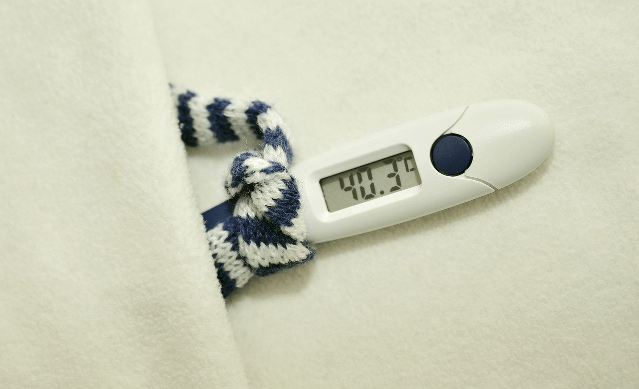
Sure sign of high fever
Your body’s immune system will direct more blood to the tattooed area to help heal the fresh wound. Thus, it’s normal for a new tattoo to feel warm to the touch. However, if after several days, it still feels abnormally warm, then it’s a sign your body’s fighting off an infection.
13. Bleeding
Bleeding’s entirely normal during the tattooing session, but afterwards? Not so much. You may see a bit of plasma and blood leaking during the first few days, and that’s totally normal. However, if the blood doesn’t let up (like you’re literally bleeding), then you’re maybe looking at a tattoo infection. If you think you’ve lost too much blood, then please go directly to the nearest hospital’s A&E department!
14. Swollen lymph nodes
A swollen lymph node is never a good sign. It’s because when they swell up it’s a sign that an infection has already occurred. Now, there are hundreds of lymph nodes in the human body, but the ones you can actually feel are under the jaw, sides of the neck, armpits, and in your groin area. If you press around these areas and you notice inflammation and tenderness to touch, then your lymph nodes are definitely swollen.
How to treat an infected tattoo
You’re probably thinking you shouldn’t have to deal with an infected tattoo on your own. And you’re probably right. Especially if the infection’s too far gone and you just know you can’t treat it with a few doses of antibiotics and over-the-counter medicine. In this case, a visit to your GP or even the A&E may be your best bet.
But, let’s say you caught your infection right at the beginning. Well, here are a few infected tattoo treatment options you may want to consider:
- Clean the infected area
If you think your tattoo is infected, then it’s best to clean the area so that the infection doesn’t spread out. Wash your hands first, then clean it with lukewarm water and antibacterial soap, then let it air dry for a bit. Apply a thin layer of ointment like Aquaphor or A+D, but NOT Vaseline because that is 100% petroleum jelly. It won’t allow your skin to breathe and can further aggravate the infection.
- Air it out
Your skin needs to breathe too. It’s just a part of the body’s healing process. The only reason your tattooist cut off oxygen supply right after he finishes working on you is to protect the tattoo as you go on home. After that, it’s not advisable to re-wrap it again as that can cause an infection.
- Ice therapy
Might sound counterproductive, but only if you apply ice directly on the wound. Ice actually works great at lessening the itch and the swelling. But you need to cover your tattoo first with clean cloth and only then can you put the ice on top.
- Cover it with a bandage
Bandaging works great if you use material that’s breathable. Cling films (the one tattooists use) aren’t breathable, so they’re not advisable for home use. But if you use something like clean gauze which lets the skin breathe, then it should be fine.
- Take medicine and/or painkillers
Before you attempt to self-medicate, seek your GP’s advice first. They know your situation best. For some people though, an OTC anti-inflammatory pill, oral or topical antibiotic, and painkillers will do wonders. But again, please consult with a licensed physician before taking anything!
- Avoid the sunlight like the plague
Sunlight’s not your fresh tattoo’s friend. The ink could react with the sun and make it fade faster than it’s supposed to (tattoos will eventually fade over time). Don’t even think about putting sunblock lotion on an oozing tattoo as it can get infected that way. However, once sufficient time has passed and the outer layers of your skin has started to heal, then sunblock and moisturising lotions become an essential part of your aftercare routine.
Related article: Does Coconut Oil Fade Tattoos?
Conclusion
Don’t ignore the signs of an infected tattoo. Seek medical help if you’ve tried treating the infection at home and nothing seems to be working. At the very least, listen to what your body is telling you. If you feel off and the tattoo looks worse for the wear, contact your GP straight away.

